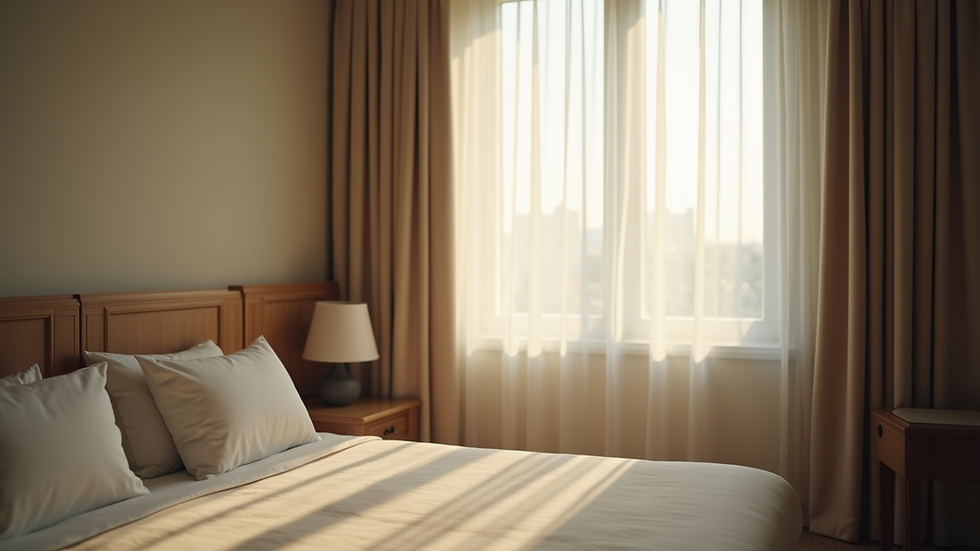The Subtle Art of Creating Calming Spaces Through Design Psychology
- Journalising Designers
- Jul 14, 2025
- 3 min read
“Why do some rooms make us breathe easier? Here’s the hidden formula: muted tones, rhythmic lines, soft finishes, and filtered light.”
Creating a calming space within a home, workspace, or any environment can drastically improve the well-being of the individuals who inhabit it. While many might approach design merely from aesthetic viewpoints, the psychology behind the elements we choose plays a crucial role in how we feel within our spaces. In this blog post, we will explore the four key elements of calming spaces: tone, texture, rhythm, and light.
Tone
The tone is perhaps the most immediately noticeable aspect of a space. Color influences mood significantly, and the correct palette can make all the difference in creating a soothing environment. Soft, muted tones—such as pastels, earth tones, or gentle blues—are often preferred for calming spaces as they create an atmosphere of tranquility.
Colors have psychological implications; for example, blue is typically associated with calmness and serenity, while green can evoke feelings of balance and harmony. On the other hand, overly bright or neon colors can stimulate the mind and evoke anxiety.
Selecting colors that evoke serenity can set the foundation for a calming space. When considering paint, wallpaper, or furnishings, lean towards tones that provide a sense of peace rather than outright stimulation.

Texture
Texture adds another layer to the design psychology behind calming spaces. The tactile quality of surfaces can elicit feelings of comfort and coziness. Soft finishes such as plush textiles, smooth ceramics, or natural fibers can create an inviting atmosphere.
Mixing textures—like combining a furry throw with a hard wooden coffee table—can create a dynamic but still cohesive environment. Textures can be interpreted differently based on their materials; for example, the warmth of wood contrasts nicely against cool, sleek metals, creating a balance that can soothe agitation.
When choosing finishes for your space, think about velvety cushions, soft rugs, and warm woods. These elements not only contribute to the aesthetic appeal but also enhance the overall experience of the room.

Rhythm
Rhythm in design refers to the repetition of elements that create a harmonious flow within a room. This could be in the form of patterns, shapes, or lines. Establishing visual rhythm—whether through aligned furniture, repeated colors, or consistent decorative motifs—can create a sense of order and predictability that is inherently calming.
Consider the arrangement of furniture. Intentionally organized seating areas or aligned artwork can lead to a more peaceful environment. Uneven or chaotic configurations can induce tension or disarray.
Creating a rhythm is about finding balance. Ensure that you incorporate elements that yield a sense of coherence throughout the space, leading to a tranquil ambiance that supports relaxation and well-being.
Light
Natural light is one of the most impactful elements in any space. It affects mood, energy levels, and even productivity. Well-filtered light can enhance a room’s tone and texture, deepening the calming effect.
Opt for soft lighting sources such as lamps with warm bulbs, instead of relying solely on harsh overhead lights. Filtering natural light through sheer curtains can create a soft glow, contributing to the tranquil atmosphere. Adjustable lighting options, like dimmers, allow you to tailor the mood according to the time of day and activity.
In spaces where natural light is limited, consider incorporating light colors in furnishings or using mirrors to reflect light, creating an illusion of a brighter environment.

Conclusion
Creating calming spaces is not merely an exercise in aesthetics but a purposeful endeavor rooted in design psychology. By thoughtfully selecting tones, textures, rhythms, and lighting, you can transform any environment into a sanctuary of peace and solace.
Whether you’re designing your home or re-arranging a workspace, remember the profound impact of these elements on your emotional landscape. By prioritizing calm within your spaces, you are not only enhancing your aesthetic experience but also nurturing your mental and emotional well-being.
Designing for calmness might take some trial and error, but once you find that right combination, you'll not just decorate a space; you’ll cultivate a serene environment where you can truly breathe easier.
